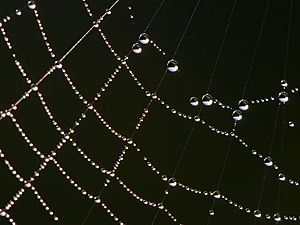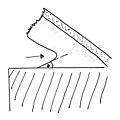Adhesion facts for kids
Adhesion is the process in which dissimilar particles stick together. In the case of similar particles, this effect is called cohesion. Adhesion results from the physical properties of the interface between two phases. The forces that result in adhesion are not fully known, there are different explanations. Five different types of adhesion have been proposed:
- Mechanical adhesion: Adhesive materials fill the voids or pores, and interlock
- Chemical adhesion: Where they join, two materials form a Chemical compound.
- Dispersive adhesion: Two materials are held together by Van der Waals forces
- Electrostatic adhesion: Two materials are held together by electrostatic charge
- Diffusive adhesion: Two materials are held together with Atomic diffusion
Images for kids
-
Concave meniscus is caused due to adhesion.
-
Water droplets are flatter on a Hibiscus flower which shows better adhesion.
-
The two stages of PDMS microstructure collapse due to van der Waals attractions. The PDMS stamp is indicated by the hatched region, and the substrate is indicated by the shaded region. A) The PDMS stamp is placed on a substrate with the "roof" elevated. B) Van der Waals attractions make roof collapse energetically favorable for PDMS stamp.
-
The interface is indicated by the dotted line. A) Non-crosslinked polymers are somewhat free to diffuse across the interface. One loop and two distal tails are seen diffusing. B) Crosslinked polymers not free enough to diffuse. C) "Scissed" polymers very free, with many tails extending across the interface.
See also
 In Spanish: Adhesión para niños
In Spanish: Adhesión para niños
 | DeHart Hubbard |
 | Wilma Rudolph |
 | Jesse Owens |
 | Jackie Joyner-Kersee |
 | Major Taylor |








